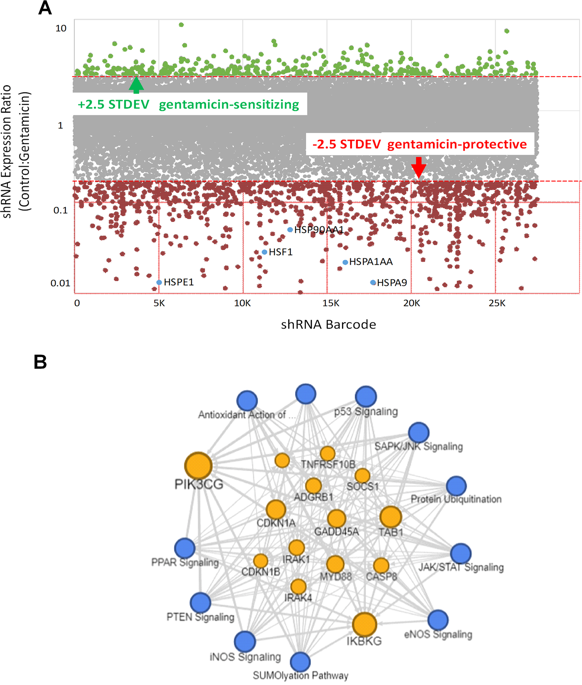Cell Death & Disease ( IF 8.1 ) Pub Date : 2020-04-03 , DOI: 10.1038/s41419-020-2382-7 Chinaemere Igwebuike 1 , Julia Yaglom 2, 3 , Leah Huiting 4 , Hui Feng 4 , Joshua D Campbell 5 , Zhiyong Wang 1 , Andrea Havasi 1 , David Pimentel 6 , Michael Y Sherman 3, 6 , Steven C Borkan 1

|
Gentamicin is a nephrotoxic antibiotic that causes acute kidney injury (AKI) primarily by targeting the proximal tubule epithelial cell. The development of an effective therapy for gentamicin-induced renal cell injury is limited by incomplete mechanistic insight. To address this challenge, we propose that RNAi signal pathway screening could identify a unifying mechanism of gentamicin-induced cell injury and suggest a therapeutic strategy to ameliorate it. Computational analysis of RNAi signal screens in gentamicin-exposed human proximal tubule cells suggested the cross-organelle stress response (CORE), the unfolded protein response (UPR), and cell chaperones as key targets of gentamicin-induced injury. To test this hypothesis, we assessed the effect of gentamicin on the CORE, UPR, and cell chaperone function, and tested the therapeutic efficacy of enhancing cell chaperone content. Early gentamicin exposure disrupted the CORE, evidenced by a rise in the ATP:ADP ratio, mitochondrial-specific H2O2 accumulation, Drp-1-mediated mitochondrial fragmentation, and endoplasmic reticulum–mitochondrial dissociation. CORE disruption preceded measurable increases in whole-cell oxidative stress, misfolded protein content, transcriptional UPR activation, and its untoward downstream effects: CHOP expression, PARP cleavage, and cell death. Geranylgeranylacetone, a therapeutic that increases cell chaperone content, prevented mitochondrial H2O2 accumulation, preserved the CORE, reduced the burden of misfolded proteins and CHOP expression, and significantly improved survival in gentamicin-exposed cells. We identify CORE disruption as an early and remediable cause of gentamicin proteotoxicity that precedes downstream UPR activation and cell death. Preserving the CORE significantly improves renal cell survival likely by reducing organelle-specific proteotoxicity during gentamicin exposure.
中文翻译:

跨细胞器应激反应破坏促进庆大霉素诱导的蛋白质毒性。
庆大霉素是一种肾毒性抗生素,主要通过靶向近端肾小管上皮细胞引起急性肾损伤 (AKI)。庆大霉素诱导的肾细胞损伤的有效疗法的开发受到不完整机制认识的限制。为了应对这一挑战,我们提出 RNAi 信号通路筛选可以确定庆大霉素诱导的细胞损伤的统一机制,并提出改善其的治疗策略。对庆大霉素暴露的人近曲小管细胞中 RNAi 信号筛选的计算分析表明,跨细胞器应激反应 (CORE)、未折叠蛋白反应 (UPR) 和细胞伴侣是庆大霉素诱导损伤的关键目标。为了验证这一假设,我们评估了庆大霉素对 CORE、UPR 和细胞伴侣功能的影响,并测试了增强细胞伴侣含量的治疗效果。早期庆大霉素暴露破坏了 CORE,表现为 ATP:ADP 比率升高、线粒体特异性 H 2 O 2积累、Drp-1 介导的线粒体断裂以及内质网-线粒体解离。 CORE 破坏先于全细胞氧化应激、错误折叠蛋白含量、转录 UPR 激活及其不良下游影响(CHOP 表达、PARP 裂解和细胞死亡)显着增加。香叶基香叶基丙酮是一种治疗剂,可增加细胞伴侣含量,防止线粒体 H 2 O 2积累,保留 CORE,减少错误折叠蛋白和 CHOP 表达的负担,并显着提高庆大霉素暴露细胞的存活率。 我们认为 CORE 破坏是庆大霉素蛋白毒性的一个早期且可补救的原因,发生在下游 UPR 激活和细胞死亡之前。保留 CORE 可能通过减少庆大霉素暴露期间细胞器特异性蛋白毒性来显着提高肾细胞存活率。











































 京公网安备 11010802027423号
京公网安备 11010802027423号